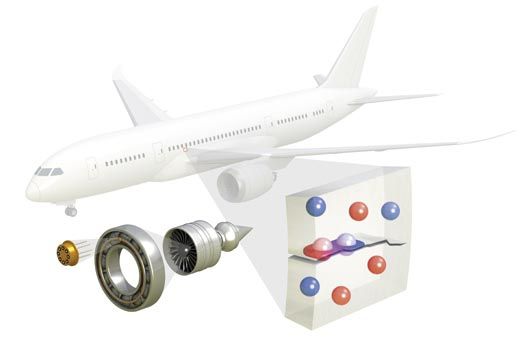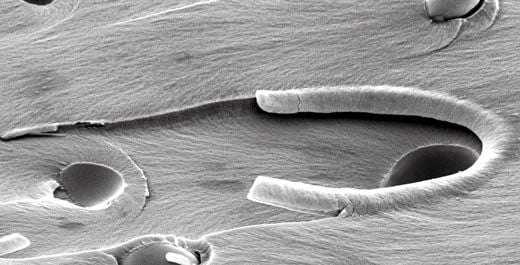How Things Work: Self-Healing Airplanes
Several technologies that could put mechanics out of work.
/https://tf-cmsv2-smithsonianmag-media.s3.amazonaws.com/filer/Today_HTW_Flash_AUG09.jpg)
When Soviet designer Andrei Tupolev completed the ANT-20, or Maxim Gorky, in 1934, it was not only the world’s largest airplane, it was among the most innovative. He built the wings with crawl spaces so mechanics could tinker with the eight engines literally on the fly. By contrast, today’s designers are eliminating the human from the task of making in-flight repairs. With revolutionary materials, micro-electronic devices, micro-sensing, and wireless technology, tomorrow’s airplanes will repair themselves.
“A lot of it has to do with advances in polymer composites,” says Nancy Sottos, professor of materials science and engineering at the University of Illinois. “How to add structural fibers, pigments, or other ingredients to polymers is well established. We have good control over the surface chemistry.”
Sottos and her colleagues in the Autonomous Materials Systems Research Group have been pioneers of self-healing composites, which mimic how plants and animals heal wounds. The researchers have developed tiny capsules of liquid solvent that bleed when the structure cracks, sealing the damage. Similarly, Ian Bond of the Department of Aerospace Engineering at the University of Bristol in England works with minuscule glass tubes incorporated into various composites. “We cut ourselves, we bleed, and heal. It’s the same kind of idea,” Bond says. In World War II, the idea produced self-sealing fuel tanks on Allied aircraft; a rubber bladder lined the tanks and swelled shut when punctured. Today, tests have shown that some composites reclaim up to 90 percent of their strength.
Self-healing materials are not yet flying. Easier detection of cracks in composites will come first—Boeing’s 787, for example, will be half carbon fiber reinforced plastic and other composites by weight, most of it in the fuselage and wings. Detecting damage takes time and effort, usually involving ultrasound equipment. One proposed damage-revealing material would use liquid within embedded vessels, Bond says; the liquid might enable “self-healing, or it could just be some kind of bruise” that highlights an area of damage.
Nikhil Koratkar, a professor at Rensselaer Polytechnic Institute in Troy, New York, has developed a composite embedded with electrically conductive carbon nanotubes blended with a heat-activated healing agent. He sends electricity across the structure, and when the current travels around a crack, its resistance increases. This heats the composite and the crack, which melts the healing agent, which then flows into the crack and returns the structure to 70 percent of its original strength.
Self-healing aircraft may be the long-term aim of the research, but they’re high-risk, with a long and involved qualification process. For now, researchers are looking at non-aviation uses. Bond is considering windmills. “They’re wings, after all,” he says.
Exposed wires may one day be fixable in flight. The Federal Aviation Administration has been sponsoring Bob Kauffman, a research chemist at the University of Dayton Research Institute, to develop the application of a water-soluble substance that becomes an insoluble polymer coating when it contacts a live wire. The substance can be sprayed directly onto a wire bundle, or embedded between the wire and its rubber coating during manufacturing. The wire then seals itself when exposed to, say, the moisture from condensation an airliner gathers as it descends.
A self-healing airplane, says Byron Pipes, professor of engineering at Purdue University, is “infatuating to people because it would require no intervention.” Self-healing, he adds, is the logical result of intelligent sensing and prognostics.
Purdue researcher Dimitrios Peroulis is working with the U.S. Air Force to develop sensors able to monitor bearing viability in jet engines. His colleague Doug Adams says that the information will allow mechanics to swap out a bearing that’s about to fail and leave others to complete their life cycles. Current protocols require throwing away good parts according to a maintenance schedule. If they’re self-monitoring, says Adams, “while the individual parts will be more expensive, you’ll save money, as you’ll replace them less often. It also means the machines will be in service longer between maintenance checks.”
Composite materials have already made the 787 about 20 percent lighter than if it were made with the amount of aluminum found in previous jetliners. Future ones will be lighter still, more efficient, cheaper to maintain, and profitable for longer periods. If you combine these advances with self-healing, Pipes says, “now, that’s the dream.” Just not the dream of a mechanic in need of steady work.
Tom LeCompte won a 2009 Aerospace Journalist of the Year award for his Air & Space article “The Disorient Express” (Aug./Sept. 2008).

